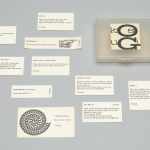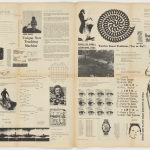
Takehisa Kosugi (1938-2018)
” “Keep walking intently.” That straightforward instruction formed the entire score for Takehisa Kosugi’s Theatre Music. … Theatre Music was one of a series of the Japanese artist’s “Event” pieces, printed on a set of cards and published in 1964 by George Maciunas, founder of the Fluxus movement.” [credit]
“The most generically titled of his Fluxus scores, Theater Music, is deceptive in its indeterminacy and formulation. Patently without object, and strikingly unmusical, it simply instructs: “Keep walking intently.” It is worth pausing to consider this. The piece brings focus, even determination to a daily action. Calling on the impetus of the individual or the collective, there is the fundamental element of endurance, an intensity in commonality, compressed within the borders of its time; space is thickened by a threat of the interminable. The otherwise quotidian activity of walking is framed as out of the ordinary by the “theater” of its execution. And through its accessibility, like the simplest Fluxus works, including others by Kosugi, it has continued to take on meaning through unlikely executions.” [credit]
Takehisa Kosugi
Theatre Music
New York City, USA: Fluxus, 1963
card: 5.5 x 11 cm., foldout: various sizes
Edition size unknown
Most copies of Fluxus 1 contained both the score card for Theatre Music (“Keep Walking Intently”) and the realization of the work: footprints on paper. The card also appears in Kosugi’s boxed work Events, and is reproduced in the second Fluxus newspaper.
The George Maciunas designed graphic of seventy-three boots in a spiral pattern is among his more iconic images.
A recent book on walking in the arts takes its title from the Kosugi work: Keep Walking Intently: The Ambulatory Art of the Surrealists, the Situationist International, and Fluxus, by Lori Waxman (2017).
The Fluxus 1 realization of the composition is similar to Yoko Ono’s Painting to Be Stepped On.
“In Theatre Music the performer is concerned with a simple unity of time, space and bodily movement. The persistence (“Keep”, “Intently”) takes on a savagely physical character in Music for a Revolution: “Scoop out one of your eyes five years from and do the same with the other eye five years later”.”– Michael Nyman, Experimental Music: Cage and Beyond
[credit]

